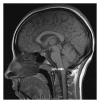Combined spinal-epidural analgesia for laboring parturient with Arnold-Chiari type I malformation: a case report and a review of the literature
- PMID: 23606989
- PMCID: PMC3623113
- DOI: 10.1155/2013/512915
Combined spinal-epidural analgesia for laboring parturient with Arnold-Chiari type I malformation: a case report and a review of the literature
Abstract
Anesthetic management of laboring parturients with Arnold-Chiari type I malformation poses a difficult challenge for the anesthesiologist. The increase in intracranial pressure during uterine contractions, coughing, valsalva maneuvers, and expulsion of the fetus can be detrimental to the mother during the process of labor and delivery. No concrete evidence has implicated high cerebral spinal fluid pressure on maternal and fetal complications. The literature on the use of neuraxial techniques for managing parturients with Arnold-Chiari is extremely scarce. While most anesthesiologists advocate epidural analgesia for management of labor pain and spinal anesthesia for cesarean section, we are the first to report the use of combined spinal-epidural analgesia for managing labor pain in a pregnant woman with Arnold-Chiari type I malformation. Also, we have reviewed the literature and presented information from case reports and case series to support the safe usage of neuraxial techniques in these patients.
Figures
Similar articles
-
Epidural Anesthesia for Cesarean Section for Parturient with Recently Diagnosed Asymptomatic Chiari Malformation Type I: A Case Report.HCA Healthc J Med. 2021 Dec 29;2(6):407-410. doi: 10.36518/2689-0216.1291. eCollection 2021. HCA Healthc J Med. 2021. PMID: 37427396 Free PMC article.
-
Uneventful epidural labor analgesia and vaginal delivery in a parturient with Arnold-Chiari malformation type I and sickle cell disease.Arch Gynecol Obstet. 2007 Apr;275(4):311-3. doi: 10.1007/s00404-006-0215-2. Epub 2006 Aug 16. Arch Gynecol Obstet. 2007. PMID: 16912855
-
Spinal neuraxial anaesthesia for caesarean section in a parturient with type I Arnold Chiari malformation and syringomyelia.SAGE Open Med Case Rep. 2018 Jun 28;6:2050313X18786114. doi: 10.1177/2050313X18786114. eCollection 2018. SAGE Open Med Case Rep. 2018. PMID: 30013789 Free PMC article.
-
Chiari I malformation and pregnancy: a comprehensive review of the literature to address common questions and to guide management.Acta Neurochir (Wien). 2020 Jul;162(7):1565-1573. doi: 10.1007/s00701-020-04308-7. Epub 2020 Apr 18. Acta Neurochir (Wien). 2020. PMID: 32306160
-
[Neuraxial analgesia during labor in a patient with Arnold-Chiari type I malformation and syringomyelia].Rev Esp Anestesiol Reanim. 2007 May;54(5):317-21. Rev Esp Anestesiol Reanim. 2007. PMID: 17598723 Review. Spanish.
Cited by
-
Anesthetic management for cesarean delivery in a woman with congenital atlantoaxial dislocation and Chiari type I anomaly: a case report and literature review.BMC Pregnancy Childbirth. 2021 Apr 1;21(1):272. doi: 10.1186/s12884-021-03751-3. BMC Pregnancy Childbirth. 2021. PMID: 33794807 Free PMC article. Review.
-
Epidural Anesthesia for Cesarean Section for Parturient with Recently Diagnosed Asymptomatic Chiari Malformation Type I: A Case Report.HCA Healthc J Med. 2021 Dec 29;2(6):407-410. doi: 10.36518/2689-0216.1291. eCollection 2021. HCA Healthc J Med. 2021. PMID: 37427396 Free PMC article.
-
Pregnancy in spina bifida patients: a comparative analysis of peripartum procedures and complications.Childs Nerv Syst. 2023 Mar;39(3):625-632. doi: 10.1007/s00381-022-05705-2. Epub 2022 Oct 24. Childs Nerv Syst. 2023. PMID: 36278978
-
Chiari I malformation: Case report of a postnatal diagnosis and literature review.Obstet Med. 2022 Mar;15(1):65-67. doi: 10.1177/1753495X20975941. Epub 2020 Dec 29. Obstet Med. 2022. PMID: 35444722 Free PMC article.
-
Anesthetic management in a patient with Arnold-Chiari malformation type 1,5: A case report.Clin Case Rep. 2022 Feb 4;10(2):e05194. doi: 10.1002/ccr3.5194. eCollection 2022 Feb. Clin Case Rep. 2022. PMID: 35140940 Free PMC article.
References
-
- Bejjani GK. Definition of the adult Chiari malformation: a brief historical overview. Neurosurgical Focus. 2001;11(1):1–8. - PubMed
-
- Bejjani GK, Cockerham KP. Adult Chiari malformation. Contemporary Neurosurgery. 2001;23(26):1–7.
-
- Landau R, Giraud R, Delrue V, Kern C. Spinal anesthesia for cesarean delivery in a woman with a surgically corrected Type I Arnold Chiari malformation. Anesthesia and Analgesia. 2003;97(1):253–255. - PubMed
-
- Chantigian RC, Koehn MA, Ramin KD, Warner MA. Chiari I malformation in parturients. Journal of Clinical Anesthesia. 2002;14(3):201–205. - PubMed
-
- Kuczkowski KM. Spinal anesthesia for Cesarean delivery in a parturient with Arnold-Chiari type I malformation. Canadian Journal of Anesthesia. 2004;51(6):p. 639. - PubMed
LinkOut - more resources
Full Text Sources
Other Literature Sources


